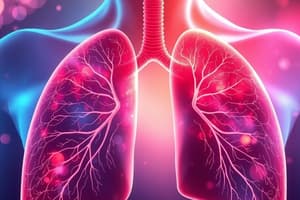Podcast
Questions and Answers
A patient with influenza is prescribed an antiviral medication. What is the primary goal of antiviral treatment in this case?
A patient with influenza is prescribed an antiviral medication. What is the primary goal of antiviral treatment in this case?
- Curing the influenza infection completely.
- Providing long-term immunity against future influenza strains.
- Preventing secondary bacterial infections.
- Reducing the duration and severity of symptoms. (correct)
A patient is diagnosed with pneumonia. Which nursing intervention is the highest priority in the initial care plan?
A patient is diagnosed with pneumonia. Which nursing intervention is the highest priority in the initial care plan?
- Providing nutritional support to enhance recovery.
- Administering antibiotics as prescribed.
- Encouraging deep breathing and coughing exercises.
- Monitoring respiratory status and ensuring adequate oxygenation. (correct)
A client is prescribed isoniazid (INH) for the treatment of tuberculosis (TB). What key teaching point should the nurse emphasize regarding this medication?
A client is prescribed isoniazid (INH) for the treatment of tuberculosis (TB). What key teaching point should the nurse emphasize regarding this medication?
- Alcohol consumption should be avoided while taking INH. (correct)
- INH should be taken on an empty stomach to maximize absorption.
- INH commonly causes orange discoloration of bodily fluids.
- Vision changes should be reported immediately.
A patient who had chest surgery is in the post-operative period. What nursing intervention is most important for preventing respiratory complications?
A patient who had chest surgery is in the post-operative period. What nursing intervention is most important for preventing respiratory complications?
A patient with COPD is prescribed a combination inhaler containing fluticasone propionate/salmeterol. What information is most important for the nurse to emphasize when teaching the patient about this medication?
A patient with COPD is prescribed a combination inhaler containing fluticasone propionate/salmeterol. What information is most important for the nurse to emphasize when teaching the patient about this medication?
An ABG result shows a pH of 7.30, PaCO2 of 50 mmHg, and HCO3- of 24 mEq/L. How would you interpret these results?
An ABG result shows a pH of 7.30, PaCO2 of 50 mmHg, and HCO3- of 24 mEq/L. How would you interpret these results?
Which of the following is the most significant risk factor for developing skin cancer?
Which of the following is the most significant risk factor for developing skin cancer?
A patient with psoriasis is prescribed a topical corticosteroid. What should the nurse include in the teaching about its application?
A patient with psoriasis is prescribed a topical corticosteroid. What should the nurse include in the teaching about its application?
A patient with Parkinson's disease is taking carbidopa/levodopa. The nurse assesses the patient for potential side effects. Which of the following is a common side effect associated with this medication?
A patient with Parkinson's disease is taking carbidopa/levodopa. The nurse assesses the patient for potential side effects. Which of the following is a common side effect associated with this medication?
Which of the following is a primary characteristic of Amyotrophic Lateral Sclerosis (ALS)?
Which of the following is a primary characteristic of Amyotrophic Lateral Sclerosis (ALS)?
Flashcards
Influenza
Influenza
Viral infection distinct from the common cold, potentially leading to severe complications.
Pneumonia
Pneumonia
An infection of the lungs that can be a complication of influenza or other respiratory illnesses; requires comprehensive care and prioritization.
Tuberculosis (TB)
Tuberculosis (TB)
A chronic bacterial infection, client education for TB drug treatment (e.g., isoniazid) is important for adherence and managing side effects.
Lung Cancer
Lung Cancer
Signup and view all the flashcards
COPD
COPD
Signup and view all the flashcards
Cor Pulmonale
Cor Pulmonale
Signup and view all the flashcards
Acid-Base Balance
Acid-Base Balance
Signup and view all the flashcards
Skin Cancer
Skin Cancer
Signup and view all the flashcards
Cellulitis
Cellulitis
Signup and view all the flashcards
Psoriasis
Psoriasis
Signup and view all the flashcards
Study Notes
Influenza
- Influenza is distinct from the common cold.
- Antiviral drugs can be used to treat influenza.
- Potential complications of influenza should be considered.
Pneumonia
- Key aspects of pneumonia care and priorities need to be understood.
Tuberculosis (TB)
- Client education regarding TB drug treatment, especially isoniazid, is essential.
Lung Cancer
- Recognition of lung cancer signs is important.
- Preoperative and postoperative management of chest surgery are vital in lung cancer care.
Chronic Obstructive Pulmonary Disease (COPD)
- Client education is necessary for COPD drug treatments, which may overlap with asthma medications.
- Fluticasone propionate/salmeterol, ipratropium, and albuterol are examples of drugs, delivered through various routes and inhaler types, used in COPD management.
- Management strategies for acute exacerbations of COPD differ from those for long-term management.
- Cor Pulmonale, a complication of COPD, needs to be understood.
Acid-Base Balance
- Alkalosis can be metabolic or respiratory in origin.
- Acidosis can be metabolic or respiratory in origin.
- Management of acid-base imbalances focuses on prevention, recognizing clinical manifestations (CMs), and restoring balance, depending on the underlying cause.
- Arterial Blood Gas (ABG) results need to be interpreted to determine acid-base imbalances.
Integumentary Problems
- Skin cancers include basal cell carcinoma, squamous cell carcinoma, and melanoma.
- Risk factors for skin cancers should be identified.
- Health promotion strategies for preventing skin cancer are important.
- Cellulitis requires specific nursing interventions.
- Psoriasis needs appropriate management.
- General nursing management principles apply to various skin problems.
Degenerative Neurologic Disorders
- Multiple sclerosis (MS) is a key degenerative neurologic disorder.
- Parkinson's disease is characterized by specific symptoms and treatments; carbidopa/levodopa is a common medication.
- Amyotrophic lateral sclerosis (ALS) is another focus of study.
Studying That Suits You
Use AI to generate personalized quizzes and flashcards to suit your learning preferences.





